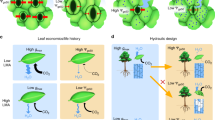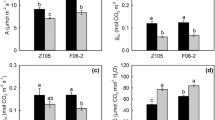Abstract
CHEMICALS which close stomata have been described by Zelitch1. When sprayed on leaf surfaces, the compounds decrease transpiration and photosynthesis of detached leaves2 and of maize plants in soil3 by increasing the diffusion resistance of stomata. When sprayed on intact tobacco plants in the greenhouse2 or on sunflowers growing in bins of soil outdoors3, the compounds reduced the loss of water from the soil. It remained to demonstrate the effect of chemical closure of stomata on transpiration by a population of plants in the field.
Similar content being viewed by others
References
Zelitch, I., Proc. U.S. Nat. Acad. Sci., 47, 1423 (1961).
Zelitch, I., and Waggoner, P. E., Proc. U.S. Nat. Acad. Sci., 48, 1101, 1297 (1962).
Shimshi, D., Plant Physiol. (in the press and in preparation).
Morris, L. G., J. Agric. Eng. Res., 4, 161 (1959).
Penman, H. L., Rep. Thirteenth Intern. Hort. Cong. London, 2, 913 (1953).
Monteith, J. L., in Environmental Control of Plant Growth, edit. by Evans. L. T., 95 (Academic Press, New York, 1963).
Author information
Authors and Affiliations
Rights and permissions
About this article
Cite this article
WAGGONER, P., MONTEITH, J. & SZEICZ, G. Decreasing Transpiration of Field Plants by Chemical Closure of Stomata. Nature 201, 97–98 (1964). https://doi.org/10.1038/201097b0
Issue Date:
DOI: https://doi.org/10.1038/201097b0
- Springer Nature Limited
This article is cited by
-
Further studies of drought resistance in woody plants
The Botanical Review (1969)
-
Effects of Phenylmercuric Acetate on Transpiration and Growth of Small Plots of Grass
Nature (1966)
-
Über den Einfluß von transpirationshemmenden Chemikalien (Antitranspirantien) auf Transpiration, CO2-Aufnahme und Wurzelwachstum von Jungfichten
Forstwissenschaftliches Centralblatt (1966)





